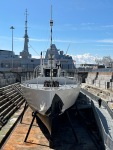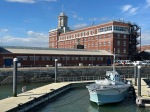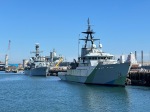Naval delights at Portsmouth
A visit to Portsmouth is always a pleasure. It’s just one of those places that I have long associated with the sheer joy of childhood, whether setting out on a holiday to Jersey by Sealink ferry from the passenger port, or visiting to explore the wonders of modern naval power during their navy days. It was always wonderful to check out which ships were visiting either way with my brother happily checking out the pendant numbers in his trusty book of naval ships. I am never away for too long and take up any excuse to return.
Today’s trip to the Historic Dockyard offered a little more of that excitement, with a harbour tour that took in the visiting French anti-submarine frigate Aquitaine, the first of her class. Construction of the Aquitaine began in 2007 at the shipyards in Lorient and she was handed over to the French navy in 2012. The Aquitaine was formally commissioned in 2015.
Other domestic sights on our harbour tour included the aircraft carrier HMS Prince of Wales; HMS Duncan (D37), a Type 45 destroyer; HMS Severn (P282), a River Class offshore patrol vessel; HMS Iron Duke (F234), a Type 23 frigate; RFA Wave Knight (A389), a Wave-class fast fleet tanker; and the rather sad sight of HMS Bristol (D23) at the end of her life.
HMS Bristol was the only vessel of the Type 82 class of desytroyer to be built for the Royal Navy, officially commissioned on 31st March 1973 and decomissioned on 28th October 2020, a life much extended by use as a training ship at Portsmouth. As the last survivor of the Falklands taskforce, as well as its one time flagship, there have been calls to preserve her as a museum ship. On our tour we were told that she would be scrapped at a Turkish scrapyard within a few months.
In the dockyard itself I was pleased to finally get a chance to step on board HMS M33, cutting a striking sight in her dazzle paint scheme. HMS M33 was ordered in March 1915, launched in May 1915, and remarkably first saw action at Gallipoli later that year. It’s hard to imagine any warship taking such a speedy path to service today.
It’s hard not to be taken in by the story of Miss Muggins, the black and white cat who lived aboard HMS M33 during the North Russia campaign and survived a number of scrapes (including falling overboard and emerging from an explosion inside the officers mess with only a burnt tail). I can’t imagine there have been many other Royal Navy warships with a catflap inserted into the wheelhouse door!
I hadn’t particularly planned to revisit HMS Victory but the current restoration work presents an unusual opportunity to see her skin peeled back to reveal the structure underneath, a view not witnessed on this scale since she was originally constructed. You can climb three levels of scaffolding to get up close to this restoration effort.
Of course, once you are on board HMS Victory, it is impossible not to be moved by the extraordinary tale of the battle of Trafalgar and Nelson’s fall. However, it’s well worth visiting the nearby museum to discover the fascinating story of how she was preserved in the first place, including an intervention from Kind Edward VII, which I was not at all familiar with.
Gallery















leave a comment